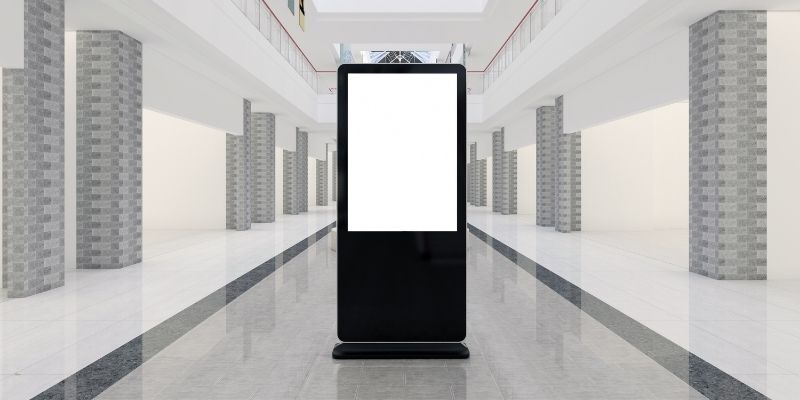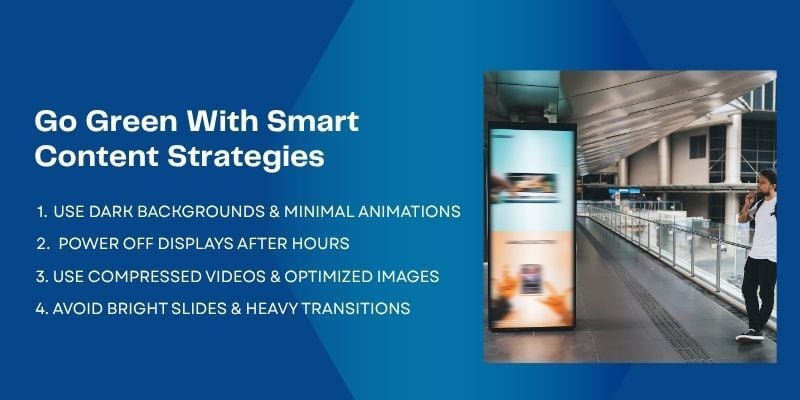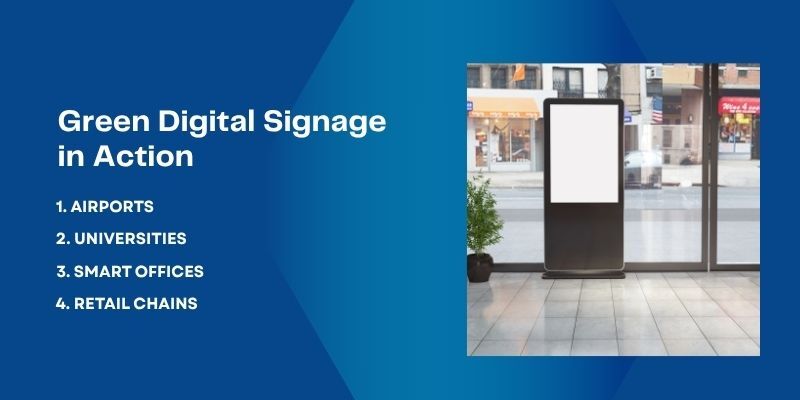At a bustling international airport, digital screens glow 24/7, guiding passengers, showcasing services, and delivering real-time updates.
Operations teams are increasingly concerned about the energy costs of these always-on displays. How much power are they actually consuming? Can their usage be optimized? Is there a more sustainable way to manage this vital communication tool?
These questions aren’t unique to airports. Across industries, from banking halls and hospital lobbies to sprawling retail chains, businesses are under increasing pressure to adopt eco-friendly practices in digital signage.
Once celebrated as greener alternatives to printed posters, digital displays now face scrutiny for their energy use, especially when screens run unnecessarily bright or remain active during off-hours.
Small choices around hardware, software, and content design can have a huge impact. Organizations that implement sustainable signage strategies can reduce waste, lower energy consumption, and align their communications with sustainability goals, all while maintaining visual impact and customer engagement.
Why Sustainability in Digital Signage Matters

Digital signage has become essential in malls, airports, schools, and corporate campuses, prized for delivering dynamic, real-time communication. Yet, when deployed without care, these screens can quietly drive up energy costs and generate avoidable electronic waste.
Consider schools, where displays often stay on long after students leave, running at full brightness without any scheduling. This inefficiency wastes resources and undermines organizations’ ESG goals.
More companies are now measuring the environmental impact of their signage as part of their sustainability efforts.
Choosing models with certified low-power profiles, built-in brightness controls, and automated sleep modes helps reduce energy consumption across extensive display networks.
Replacing printed posters with digital formats also cuts material waste and eliminates frequent reprints, creating cleaner, more efficient communication.
For businesses committed to ESG, eco-conscious signage is not merely a compliance task but a strategic move to align operations with public expectations while strengthening their brand’s reputation for responsibility.
Energy-Efficient Hardware Makes a Big Difference
Reducing the environmental footprint of digital signage begins with selecting the right hardware — solutions that deliver clear, measurable savings without compromising performance.
For example, LED screens with auto-brightness sensors adjust their brightness based on surrounding light, reducing power consumption during the day without compromising visibility.
Devices featuring low-power modes and certifications like Energy Star or TCO Certified demonstrate proven efficiency and long-term operational value.
These features matter most in environments where displays run continuously, such as schools and airports. In these settings, energy-efficient hardware can lower costs significantly and support sustainability goals.
System-on-Chip (SoC) displays take efficiency a step further by embedding media playback directly inside the screen itself.
This eliminates the need for external players, reducing electricity use, simplifying installation, and improving reliability, which are critical benefits for teams managing signage networks across multiple sites.
But hardware alone isn’t enough. Centralized control is essential for maximizing savings. Remote scheduling, automated sleep timers, and adjustable brightness enable operations teams to enforce off-hour shutdowns with minimal manual effort.
Energy-conscious procurement is becoming the norm: a recent industry survey found that 69% of technology, media, and telecom companies require suppliers to disclose greenhouse gas emissions before entering bids.
This trend means energy-efficient signage must be a design priority from the start, not an afterthought.
Across retail chains, educational campuses, and government institutions, managing energy use for signage across multiple locations is vital.
Wavetec’s display solutions are designed with these efficiency features in mind, helping organizations reduce power consumption while maintaining vibrant communication.
Today, investing in energy-efficient signage is more than a tech upgrade. It’s a strategic operational step and a clear path toward meeting ESG commitments.
Go Green With Smart Content Strategies

Eco-efficiency in digital signage isn’t just about hardware, but also how you design and schedule content.
- Choose darker backgrounds and minimal animations. Using solid, dark visuals instead of bright, dynamic content reduces strain on energy-efficient displays and lowers overall power consumption.
- Schedule displays to power off during non-business hours. Automating screen shutdowns through centralized systems avoids wasting energy overnight or on weekends.
- Use lightweight media files, optimized image formats, and compressed videos to reduce processor load and power use per display.
- Avoid heavy transitions and overly bright slides. Clean, minimal layouts support green digital signage goals while retaining message clarity.
A recent deployment by BCI Bank, a leading financial institution in Chile with over 300 branches, shows how smart content strategies and centralized control can drive sustainability and customer engagement.
Using Wavetec’s digital signage platform, Donatello, BCI programmed and managed content remotely across hundreds of screens, customizing displays by time and customer profiles while minimizing energy use during off-hours.
This system also allowed easy maintenance and bandwidth control, resulting in reduced power consumption and operational costs.
By integrating entertainment and essential information across their digital signage, BCI enhanced the customer experience while supporting their long-term environmental commitments.
Content rules aren’t just for public-facing signage. For internal communication, such as in staff rooms or corridors, light static updates that cycle less frequently can lower power usage without compromising message visibility or frequency.
Centralized Management Reduces Waste
Cloud-based digital signage management isn’t just about convenience; it’s a smart way to reduce environmental impact across multi-location deployments.
There is no need to dispatch technicians for updates, as changes occur remotely, saving fuel and reducing operational emissions.
It eliminates the need for printed posters and shipping, cutting down on paper waste and logistics overhead.
This system allows teams to schedule and update content instantly across networks, from communications in staff corridors to signage in airports, without any manual intervention. This move toward eco-friendly signage meets the rising demand from consumers.
According to PwC’s 2024 Voice of the Consumer Survey, consumers are willing to pay 9.7% more on average for sustainably sourced or produced goods, with 85% stating they’ve experienced the effects of climate change in their daily lives.
Eco-friendly signage isn’t just good practice; it’s a business advantage that connects with what audiences value most.
Lifespan, Maintenance, and Recycling Matter
The environmental impact of digital signage isn’t just about energy use. It’s also about how long hardware lasts and what happens when it’s no longer needed.
Choosing displays built for longevity reduces waste and the need for frequent replacements. Opt for models rated for at least 5 to 10 years of operation, ideally with built-in diagnostics that flag performance issues before they lead to failure.
Regular maintenance, like firmware updates and thermal checks, extends hardware life and prevents unnecessary replacements.
Equally important is what happens at the end of a product’s life. Vendors that offer e-waste recycling or take-back programs ensure devices are responsibly decommissioned and repurposed rather than sent to landfill.
This matters more than ever. Worldwide, the annual generation of e-waste is rising by 2.6 million tonnes and is on track to reach 82 million tonnes by 2030.
Reducing screen turnover and partnering with recycling-conscious suppliers supports sustainable communication solutions while lowering your total carbon footprint for signage.
Green Digital Signage in Action

Across various sectors, including airports, universities, smart offices, and retail, digital signage is reducing waste, lowering energy consumption, and enhancing customer experiences, all in clear, quantifiable ways.
1. Airports
Airports rely on efficient, real-time communication to move passengers smoothly and reduce stress.
At the Air Mauritius Customer Care Office in Port Louis, Wavetec implemented an integrated queuing and signage solution that streamlined service delivery and improved the overall experience.
The solution included low-power counter displays and overhead digital screens to manage queues and display real-time updates in both English and French. This reduced the need for printed materials and minimized confusion during peak hours.
Staff could monitor live service metrics, enabling faster decision-making and better crowd control. Passengers received clearer instructions, resulting in shorter wait times and a smoother service flow, all without increasing operational overhead or energy consumption.
2. Universities
Many universities are replacing printed posters and flyers with centralized digital signage to reduce waste and improve communication.
A great example is Metropolitan University, which deployed a campus-wide digital signage network across multiple campuses to replace printed posters with centrally managed screens.
This rollout eliminated over $2.7 million in annual printing and communication costs, while also reducing paper waste and streamlining information updates.
These displays are used for event notices, building wayfinding, and emergency alerts, cutting reliance on printed materials and aligning with sustainability goals.
The result? A clearer campus experience, fewer paper resources, and stronger carbon footprint signage awareness across all sites.
3. Smart Offices
In smart offices, digital signage replaces static bulletin boards and printed notices with real-time, scheduled content. This reduces paper waste, minimizes manual updates, and ensures that internal communication stays timely and relevant.
An example is Envoy Air (a subsidiary of American Airlines), which deployed digital signage at its headquarters in Irving, Texas. Screens were installed across employee zones, break rooms, meeting spaces, and hallways, displaying shift schedules, service metrics, and safety alerts.
The rollout eliminated the need for printed posters and manual updates, while improving staff engagement without increasing energy consumption.
Pairing highly efficient signage hardware with easy content updates enhances internal communications and supports sustainability goals without compromising performance or increasing carbon footprint.
4. Retail Chains
Retailers with large store networks need systems that are fast, consistent, and cost-effective.
In a retail signage rollout, Wavetec deployed digital displays across multiple Samsung store locations, allowing centralized teams to instantly push promotions, product highlights, or seasonal messages without relying on printed materials or manual updates.
With brightness scheduling and smart content rotation, each store optimized display energy use based on foot traffic patterns and store hours.
Back-end analytics enabled teams to adjust content in real-time, aligning campaigns with shopper behavior and reducing unnecessary screen time.
This type of system, already proven effective in retail, can also be adapted for use in hotels or other high-traffic areas where consistent messaging and energy efficiency are crucial.
Quick Checklist for Eco-Friendly Digital Signage
Eco-conscious signage is about more than screen content. It includes the hardware you choose, how it’s operated, and how it’s managed over time.
Use this checklist to keep your setup efficient and responsible:
- Choose displays with low power use and long operational lifespans.
- Automate screen on/off schedules to match working hours.
- Use static or low-motion content to reduce energy draw.
- Perform routine updates and thermal checks to extend device life.
- Reuse parts when possible or recycle through vendor take-back programs.
- Manage content remotely to avoid unnecessary travel and printed signage.
Conclusion
Sustainable digital signage is a practical upgrade. Energy-efficient displays, automated power schedules, and reduced printing lower both cost and waste.
In offices, campuses, and stores, simple steps like dimming screens or updating content remotely save power without affecting visibility.
Routine upkeep and responsible recycling extend device lifespan and keep waste out of landfills. These changes are straightforward, and they deliver results without disrupting communication.
Eco-friendly signage helps you spend less, waste less, and operate smarter.
BOOK A FREE DEMO





